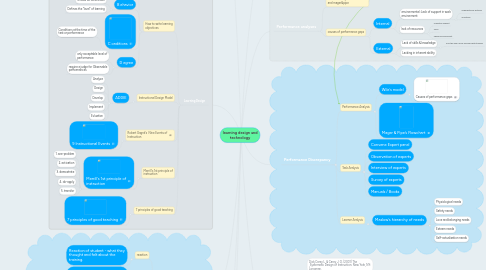
1. Needs Assessment
1.1. Prossce of Needs Assessment
1.1.1. Optimal - Actual = Gap
1.1.2. Identify the cap
1.1.3. How important the cap is?
1.1.4. Identify relevant stakeholders
1.1.5. Choose appropriate tools to use: questionnaire, interview, observation
1.1.6. To determine if training/education can correct performance gap
2. Performance analyses
2.1. different analyze models:wile's and mager&pipe
2.2. causes of performance gaps
2.2.1. Internal
2.2.1.1. environmental: Lack of support in work environment
2.2.1.1.1. Organizational systems
2.2.1.1.2. Incentives
2.2.1.2. lack of resources
2.2.1.2.1. Cognitive support
2.2.1.2.2. Tools
2.2.1.2.3. Physical environment
2.2.2. External
2.2.2.1. Lack of skills & knowledge
2.2.2.1.1. only this one.can be resolved with training.
2.2.2.2. Lacking in inherent ability
3. Performance Discrepancy
3.1. Performance Analysis
3.1.1. Wile’s model
3.1.1.1. Causes of performance gaps
3.1.2. Mager & Pipe’s Flowchart
3.2. Task Analysis
3.2.1. Convene Expert panel
3.2.2. Observation of experts
3.2.3. Interview of experts
3.2.4. Survey of experts
3.2.5. Manuals / Books
3.3. Learner Analysis
3.3.1. Maslow’s hierarchy of needs
3.3.1.1. Physiological needs
3.3.1.2. Safety needs
3.3.1.3. Love and belonging needs
3.3.1.4. Esteem needs
3.3.1.5. Self-actualization needs
4. Learning theory
4.1. Behavorism
4.1.1. Operant conditioning
4.1.1.1. Positive Reinforcement
4.1.1.2. Negative Reinforcement
4.1.1.3. Punishment
4.1.2. Classical conditioning
4.1.3. Schedules of Reinforcement
4.1.3.1. Interval schedules
4.1.3.2. time is the determining factor
4.1.3.2.1. Fixed interval schedule
4.1.3.2.2. Variable interval schedule
4.2. Cognitivism
4.2.1. Focus on the mental processes
4.2.2. Learning viewed as the acquisition of new information.
4.2.3. Cognitive Information Processing Model (Atkinson & Shiffrin, 1968)
4.3. Constructivism
4.3.1. models of experiences
4.3.2. Cosely linked to social-cultural contexts
4.3.3. Learn by constructing their own representations
4.3.4. Types of constructivism
4.3.4.1. Personal/individual constructivism
4.3.4.2. Social constructivism
4.3.5. Constructivist conditions for learning (Driscoll, 2000)
4.3.5.1. Provide for social negotiation
4.3.5.2. Encourage ownership in learning
4.3.5.3. Nurture self-reflection of knowledge construction
5. Learning Design
5.1. How to write learning objectives
5.1.1. A udience
5.1.1.1. Write for an individual student
5.1.1.2. Not always necessary to include
5.1.2. B ehavior
5.1.2.1. Should be observable
5.1.2.2. Defines the “level” of learning
5.1.3. C onditions
5.1.3.1. Conditions at the time of the test or performance
5.1.4. D egree
5.1.4.1. only acceptable level of performance
5.1.4.2. require a judge for Observable performances
5.2. Instructional Design Model
5.2.1. ADDIE
5.2.1.1. Analyze
5.2.1.2. Design
5.2.1.3. Develop
5.2.1.4. Implement
5.2.1.5. Evluation
5.3. Robert Gagné’s Nine Events of Instruction
5.3.1. 9 Instructional Events
5.4. Merrill's 1st principle of instruction
5.4.1. Merrill's 1st principle of instruction
5.4.1.1. 1. see-problem
5.4.1.2. 2. activation
5.4.1.3. 3. demostrate
5.4.1.4. 4. do-apply
5.4.1.5. 5. transfor
5.5. 7 principles of good teaching
5.5.1. 7 principles of good teaching
6. kirkpatrick's learning and training evaluation theory
6.1. reaction
6.1.1. Reaction of student - what they thought and felt about the training.
6.2. learning
6.2.1. Learning - the resulting increase in knowledge or capability
6.3. behaviour -
6.3.1. Behaviour - extent of behaviour and capability improvement and implementation/application
6.4. results
6.4.1. Results - the effects on the business or environment resulting from the trainee's performance
7. REFERENCES
7.1. Dick,Carey L, & Carey J. O. (2001) The ,Systematic Design of Instruction. New York, NY: Longman.
7.2. Mergel,B (1998). Instructional design & Learning theories
7.3. Wilson, B. G. (1996) Constructivist Learning Enviornments: case studies in instructional design. Englewood Cliffs, NJ: Education Technology Publications
7.4. Illeris, Knud (2004). The three dimensions of learning. Malabar, Fla: Krieger Pub. Co.
7.5. Leonard, David (2002). Learning theories, A to Z. Westport, Conn: Oryx Press.
7.6. Rose, D. H., and A. Meyer. 2002. Teaching every student in the Digital Age: Universal Design for Learning. Alexandria, VA: ASCD.
7.7. Reiser, R.A. (1987).Instructional technology :Foundations.In R. Gagne (Ed.), Instructional technology: Foundations. Hillsdale, NJ:Erlbum
8. OVERALL STEPS FOR INSTRUCTIONAL DESIGN ( systematic)
8.1. Assess Needs to Identify Goals
8.2. Conduct Instructional Analysis
8.3. Analysis Learner and Contect
8.4. Write performance Objectives
8.5. Develop Assessment Instruments
8.6. Develop Istructional Strategy
8.7. Develop and select Instructional Materials
8.8. Develop and Construct Formative and Summative Evaluation
9. Useful learning technology for learning design
9.1. iSpot
9.1.1. Where students, experts and members of the public share ideas on botany
9.2. MOOCs
9.2.1. Short courses that are delivered online for free
9.3. Google Apps
9.3.1. Google Apps are all about integration. As asuite, the apps can work independently, but content from one app can be pulled into another.
9.4. Social Media
9.4.1. FaceBook / Twitter / Blogger
